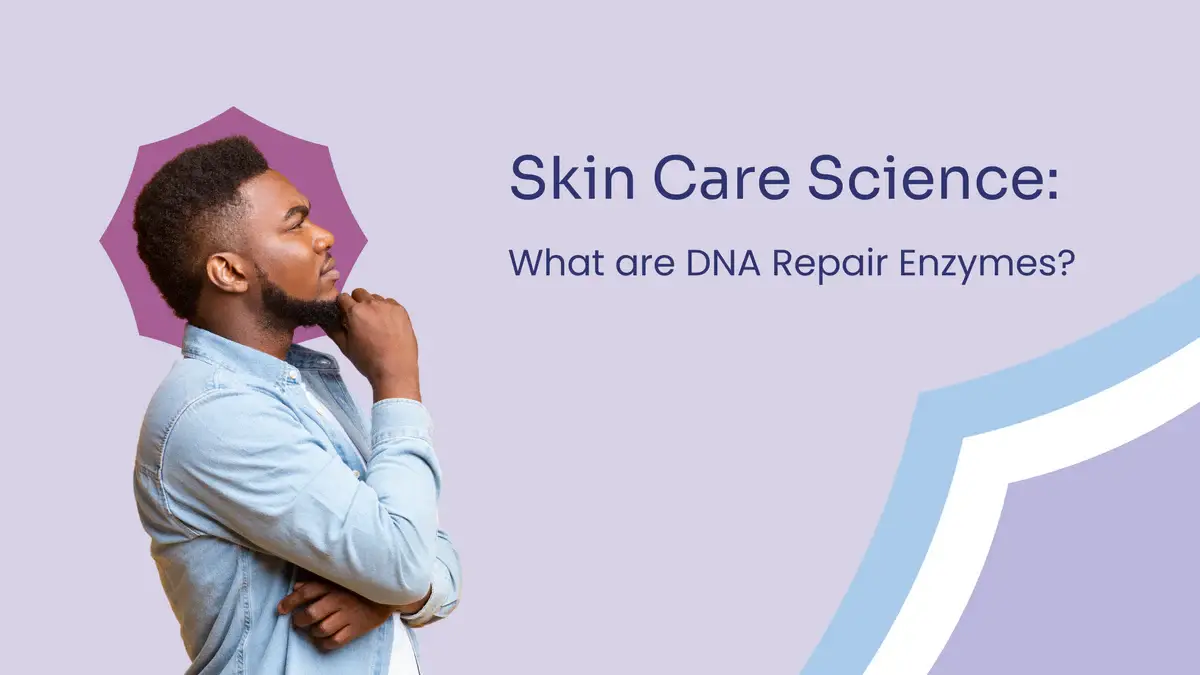
DNA Repair Enzymes in Skin Care
DNA repair enzymes are gaining popularity in antiaging skincare products. These powerful enzymes work at the cellular level to repair damage caused by environmental stressors like UV radiation, pollution, and more. Incorporating DNA enzymes into your regimen can help maintain youthful, healthy skin while preventing future damage. This blog will explore what DNA enzymes are, how they function, and which ingredients and products to look for when shopping for skincare that supports DNA repair.. These naturally occurring proteins play a vital role in protecting our skin from the damaging effects of UV radiation and other environmental stressors.
In this blog, we will discuss who should use DNA repair enzymes in skin care products, explore their benefits, and discuss how to effectively integrate them into your skincare routine.
DNA Repair
DNA repair is a crucial biological process that corrects DNA damage, which can arise from sources like UV light, pollution, free radicals, and chemicals. This process operates through a series of steps, each facilitated by specific enzymes:
Detection : Enzymes such as DNA glycosylases scan DNA to identify errors.
Excision : Enzymes like endonucleases remove the damaged DNA segment by cutting it out.
Replacement : DNA polymerases synthesize a correct sequence to replace the excised segment, similar to swapping a faulty Lego brick.
Ligation : DNA ligases rejoin the new segment to the original DNA strand, restoring its integrity.
Different organisms have distinct DNA repair enzymes tailored to their unique environmental exposures and cellular processes.
What are DNA Repair Enzymes?
DNA repair enzymes are specialized proteins that identify and correct damage to the DNA within our skin cells. There are several types of DNA repair enzymes, each with unique functions and origins. I discuss these later in this blog.
Best Skincare Products with DNA Repair Enzymes
Cleansers
While some cleansers may contain DNA repair enzymes, it is important to note that these products typically do not stay on the skin long enough to provide significant repair benefits.
Serums
For best results, apply serums with DNA Repair Enzymes to clean skin after cleansing with warm water, which increases blood flow to the area, enhancing enzyme penetration. Follow with a moisturizer to create an occlusive layer that helps drive the enzymes deeper into the skin, optimizing their repair effects.
Photozyme Youth Recovery DNA Repair Serum is my favorite dermatologist recommended DNA repair enzyme serum. But there are many good ones.
Moisturizers
Some moisturizers contain DNA repair enzymes but they do not penetrate as well as serums. I tell my patients to apply a serum with DNA repair enzymes and cover it with a moisturizer that matches their Baumann Skin Type.
Rationale #5 The Gel-Creme is a light moisturizer designed for oily skin types that supports DNA repair and enhances skin resilience. It contains these ingredients to promote DNA repair:
Micrococcus Lysate : Enzyme that repairs UV-damaged DNA.
Bifida Ferment Lysate : Ferment that strengthens skin barrier and repair.
Pseudoalteromonas Ferment Extract : Marine extract that promotes skin regeneration.
Hydrolyzed DNA : DNA fragments that support skin repair.
Acetyl Hexapeptide-51 Amide : Peptide that boosts DNA repair energy.
Arabidopsis Thaliana Extract : Plant extract aiding in DNA repair.
Rationale #6 The Night Cream is an elegant moisturizer designed for dry skin that repairs the skin barrier and supports DNA repair. This luxurious cream includes the following DNA repair ingredients:
Bifida Ferment Lysate : Ferment that strengthens skin barrier and repair.
Hydrolyzed DNA : DNA fragments that support skin repair.
Hydrolyzed RNA : RNA fragments that help in skin regeneration.
Micrococcus Lysate : Enzyme that repairs UV-damaged DNA.
Arabidopsis Thaliana Extract : Plant extract aiding in DNA repair.
Acetyl Hexapeptide-51 Amide : Peptide that boosts DNA repair energy.
These ingredients work together to enhance the skin’s natural repair processes, making this cream an excellent choice for those looking to repair and rejuvenate dry, damaged skin.
Sunscreens
Sunscreens containing DNA repair enzymes provide an extra layer of protection against UV-induced DNA damage. These products not only block UV rays from reaching the skin but also help repair any damage that may occur. Look for sunscreens that contain photolyase or endonuclease enzymes for optimal DNA repair benefits. Your skin focuses on repair processes at night, so while these sunscreens are good, you really need DNA repair at night.
Eye Creams
Rationale #6 The Eye Crème is an elegant eye treatment designed for all skin types, particularly beneficial for delicate under-eye areas, repairing the barrier and aiding in DNA repair. This luxurious eye crème includes the following DNA repair ingredients:
Arabidopsis Thaliana Extract : Plant extract aiding in DNA repair.
Micrococcus Lysate : Enzyme that repairs UV-damaged DNA.
These ingredients work together to enhance the skin’s natural repair processes, making this eye crème ideal for rejuvenating and protecting the sensitive skin around the eyes.
DNA Repair Enzymes in Your Skincare Routine
To maximize the benefits of DNA repair enzymes, it is essential to incorporate them into your skincare routine strategically. They are best used in the night routine but can also be used in your morning routine.
For optimal results, consider using a DNA repair enzyme serum after any prolonged sun exposure (over 30 minutes of direct sun) to help repair any potential damage.
Here’s a step-by-step guide for an evening skincare routine that includes DNA repair enzymes:
Step 1: Cleanse
Begin by thoroughly cleansing your skin with a gentle cleanser suitable for your skin type. This step removes dirt, oil, and impurities, preparing your skin for the subsequent products.
Step 2: Eye Cream
Apply a nourishing eye cream to address any specific concerns around the delicate eye area, such as fine lines, puffiness, or dark circles. You can choose one with DNA repair enzymes or use the same serum as step 3.
Step 3: DNA Repair Enzyme Serum
Apply a concentrated serum containing DNA repair enzymes to your face and neck. Allow the serum to absorb fully into your skin before moving on to the next step. The Photozyme Vitamin C+E Ferulic Acid Serum with DNA repair enzymes is an excellent choice for this step, as it combines the benefits of antioxidants and DNA repair enzymes.
Step 4: Moisturizer
Follow up with a moisturizer to hydrate and protect your skin. Look for a moisturizer that is appropriate for your skin type and contains additional beneficial ingredients, such as antioxidants or skin-restoring peptides.
Step 5: Retinoids or a Retinoid Alternative
See our directions when you build your custom skin care routine using our skin care regimen builder.
In some cases you may want to cycle your step 3 serum using various different antiaging products. Once you take the quiz, our custom monthly emails can help guide you on how to cycle skin care products for your skin type.
Maximize Effectiveness
Combine with ingredients that boost cellular energy like:
Niacinamide
Ubiquinone
NAD
Comparison to other Antiaging Ingredients
Follow our specific skin type recommendations to know if DNA enzymes or other antiaging ingredients are best for you because there are many choices that include antioxidants, growth factors, retinoids and other aging prevention ingredients and ingredients that restore collagen or prevent sagging skin. There are many types of antiaging ingredients that you may want to use instead of DNA repair enzymes or together with these repair enzymes such as:
Ascorbic acid- antioxidant and increases collagen and inhibits tyrosinase
Glycosaminoglycans- plump skin and help with cell signaling
Growth factors- restore collagen
Peptides- restore collagen and make skin feel firm.
Retinoids- These are my favorite antiaging ingredients and can be combined and used together with DNA repair enzymes.
Let us help you build a personalized skin care routine to find the best antiaging products to meet your unique skin concerns.
Types of DNA Repair Enzymes
There are many types of DNA repair enzymes found in skin care products such as sunscreens, serums, moisturizers, and supplements. Below I list the source, mechanism of action and INCI name found on the skin care product label for each DNA repair enzyme found in skin care products.
Photolyase
INCI Name : Photolyase
Mechanism of Action: Photolyase binds to damaged DNA and, upon absorption of visible light, uses this energy to break the bonds of the dimer caused by UV light, effectively reversing the damage.
Source : Derived from plankton extract, photolyase is commonly found in marine organisms and is adapted to repairing damage caused by solar radiation.
Endonucleases
Endonucleases in skincare products function by recognizing and cutting damaged DNA at specific sites to initiate repair processes. Endonucleases scan the DNA for damage caused by environmental factors like UV light. Upon identifying damaged or mismatched DNA segments, they make precise cuts near these sites. This action allows for the removal of damaged sections, enabling the cellular machinery to fill in the gaps with correct nucleotides, thus restoring the DNA’s integrity. Here’s the details of each commonly used endonuclease in skincare:
Micrococcus Endonuclease (Micrococcus Lysate)
Source : Derived from the bacterium Micrococcus luteus.
INCI Name : Micrococcus Lysate
T4 Endonuclease V
Source : Originally from Escherichia coli infected with bacteriophage T4.
INCI Name : None (commonly referred to by its enzyme name, sometimes encapsulated in liposomes for skincare formulations).
UV Endonuclease
Source : Generic term for enzymes that target UV-induced DNA damage, not specific to any one type but typically derived from bacteria or engineered in laboratories.
INCI Name : None (described functionally rather than by a specific chemical name).
Endonuclease V
Source : Found in a variety of organisms, including bacteria and plants, where it serves a role in DNA repair.
INCI Name : None (often listed by specific source or activity, such as “endonuclease from Arabidopsis thaliana”).
Arabidopsis Endonuclease
Source : Extracted from the plant Arabidopsis thaliana, known for its robust DNA repair mechanisms.
INCI Name : None (specifically described by its plant source).
Each of these endonucleases has a unique origin and is incorporated into skincare products to enhance the skin’s natural ability to repair DNA damage, thus contributing to skin health and reducing the aging effects of environmental stressors.
8-oxoguanine glycosylase (OGG1)
8-oxoguanine glycosylase (OGG1) is an enzyme that repairs oxidative DNA damage, specifically targeting the removal of 8-oxoguanine, a common lesion caused by reactive oxygen species from UV exposure and other environmental stressors.
Mechanism of Action: OGG1 identifies 8-oxoguanine in DNA, excises the damaged base, and initiates repair, thereby preventing mutations and maintaining genomic stability.
Source: Derived from the mustard plant (Arabidopsis thaliana).
INCI Name:OGG1 does not have a specific INCI name and is often listed as Arabidopsis thaliana
Other DNA repair Ingredients
These ingredients have less data to back up their use, but can also be found in skin care products.
Arabidopsis Thaliana Extract : Derived from a plant commonly used in scientific research, this extract is believed to aid in DNA repair processes. Although it is less frequently discussed in consumer products, its potential benefits in DNA repair make it an interesting addition to skincare formulations.
Hydrolyzed DNA : This ingredient consists of DNA broken down into smaller fragments, which are then used in skincare to support skin cell repair and regeneration. It is particularly useful in promoting the healing of damaged skin.
Acetyl Hexapeptide-51 Amide : Known for its role in protecting DNA from damage, this peptide supports DNA repair processes and helps in reducing the effects of aging on the skin.
Conclusion
There is a lot to know to find out if DNA repair enzymes are right for your skin- but don’t worry, we are here to help. Take the quiz and use our advanced AI skin care concierge to guide you towards the perfect skin care routine for you.


